
Kent is a ceremonial county in South East England. It is bordered by Essex across the Thames Estuary to the north, the Strait of Dover to the south-east, East Sussex to the south-west, Surrey to the west, and Greater London to the north-west. The county town is Maidstone.

Canterbury is a city and UNESCO World Heritage Site, in the county of Kent, England; it was a county borough until 1974. It lies on the River Stour. The city has a mild oceanic climate.

Minster, also known as Minster-in-Thanet, is a village and civil parish in the Thanet District of Kent, England. It is the site of Minster in Thanet Priory. The village is west of Ramsgate and to the north east of Canterbury; it lies just south west of Kent International Airport and just north of the River Stour. Minster is also the "ancient capital of Thanet". At the 2011 Census the hamlet of Ebbsfleet was included.
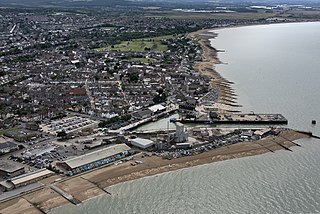
Whitstable is a town on the north coast of Kent, England, at the convergence of the Swale and the Greater Thames Estuary, five miles north of Canterbury and two miles west of Herne Bay.

Canterbury, also known as the City of Canterbury, is a local government district with city status in Kent, England. It is named after its largest settlement, Canterbury, where the council is based. The district also includes the towns of Fordwich, Herne Bay and Whitstable, along with numerous villages and surrounding rural areas. Parts of the district lie within the designated Area of Outstanding Natural Beauty of the Kent Downs.

The Southern Counties East Football League is an English football league established in 1966, which has teams based in Kent and Southeast London. Its two divisions are allocated at Step 5 and Step 6 of the National League System. At its inception it was known for two seasons as the Kent Premier League and then, until 2013, as the Kent League.

Heart Kent was an Independent Local Radio station owned and operated by Global Radio as part of the Heart network. It broadcast to Kent from studios at John Wilson Business Park in Whitstable.
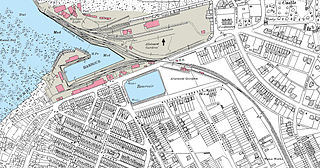
The Canterbury and Whitstable Railway, sometimes referred to colloquially as the "Crab and Winkle Line", was an early British railway that opened in 1830 between Canterbury and Whitstable in the county of Kent, England.
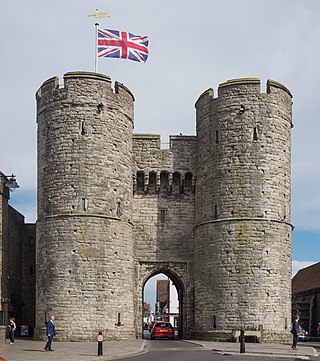
The Westgate is a medieval gatehouse in Canterbury, Kent, England. This 60-foot (18 m) high western gate of the city wall is the largest surviving city gate in England. Built of Kentish ragstone around 1379, it is the last survivor of Canterbury's seven medieval gates, still well-preserved and one of the city's most distinctive landmarks. The road still passes between its drum towers. This scheduled monument and Grade I listed building houses the West Gate Towers Museum as well as a series of historically themed escape rooms.

Invicta is an early steam locomotive, built by Robert Stephenson and Company in Newcastle-upon-Tyne during 1829. She was the twentieth locomotive built by railway engineers the Stephensons, being constructed immediately after Rocket. Invicta marked the end of the first phase of locomotive design, which had started with Richard Trevithick's Coalbrookdale locomotive of 1802.
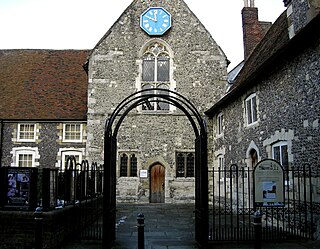
The Canterbury Heritage Museum was a museum in Stour Street, Canterbury, South East England, telling the history of the city. It was housed in the 12th-century Poor Priests' Hospital next to the River Stour. The museum exhibited the Canterbury Cross and contained a gallery dedicated to Rupert the Bear, whose creator Mary Tourtel lived in Canterbury. It held regular events and exhibitions of local and national interest. The museum closed in 2018. It has since re-opened as The Marlowe Kit; an escape room, exhibition and creative space.

Seasalter is a village in the Canterbury district of Kent, England. Seasalter is on the north coast of Kent, between the towns of Whitstable and Faversham, facing the Isle of Sheppey across the estuary of the River Swale. The settlement of Yorkletts is included in the ward. It is approximately 6 miles (10 km) north of Canterbury.

The Seaside Museum Herne Bay is a local museum in Herne Bay, Kent, England. It was established in 1932, and is notable for being a seaside tourist attraction featuring local archaeological and social history, for featuring the history of the town as a tourist resort, for its local art exhibitions and for its World War II bouncing bomb. The management of the Museum was awarded by Canterbury City Council to the Herne Bay Museum Trust, who reopened it in July 2015, as The Seaside Museum Herne Bay.

The Canterbury Roman Museum in Canterbury, Kent, houses a Roman pavement which is a scheduled monument, in the remains of a Roman courtyard house which itself is a grade I listed building. The pavement was discovered after World War II bombing, and has been open to the public since 1946. The museum was established in 1961. It houses many excavated artifacts from Roman Canterbury, including the important late Roman silver hoard known as the Canterbury Treasure, together with reconstructions of the Roman town.
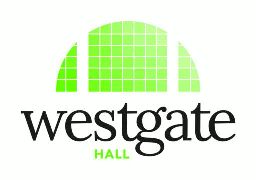
Westgate Hall is a hundred-year-old drill hall and community space in a Conservation area of Canterbury, Kent, notable for hosting community events. The Hall was threatened with closure or demolition in 2009, but a group of local people fought to save it. The building is now leased by Curzon Cinemas. Westgate Hall now hosts a range of events from parties to conferences, markets and fairs including the Westgate Hall Market.
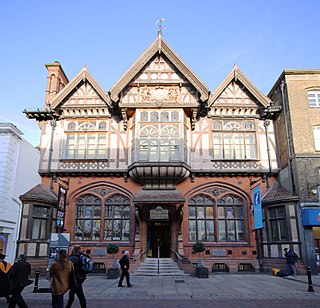
The Beaney House of Art and Knowledge is the central museum, library and art gallery of the city of Canterbury, Kent, England. It is housed in a Grade II listed building. Until it closed for refurbishment in 2009, it was known as the Beaney Institute or the Royal Museum and Art Gallery. It reopened under its new name in September 2012. The building, museum and art gallery are owned and managed by Canterbury City Council; Kent County Council is the library authority. These authorities work in partnership with stakeholders and funders.

Herne Bay Pier was the third pier to be built at Herne Bay, Kent for passenger steamers. It was notable for its length of 3,787 feet (1,154 m) and for appearing in the opening sequence of Ken Russell's first feature film French Dressing. It was destroyed in a storm in 1978 and dismantled in 1980, leaving a stub with sports centre at the landward end, and part of the landing stage isolated at sea. It was preceded by two piers: a wooden deep-sea pier designed by Thomas Rhodes, assistant of Thomas Telford, and a second shorter iron version by Wilkinson & Smith.

Hampton-on-Sea is a drowned and abandoned village in what is now the Hampton area of Herne Bay, Kent. It grew from a tiny fishing hamlet in 1864 at the hands of an oyster fishery company, was developed from 1879 by land agents, abandoned in 1916 and finally drowned due to coastal erosion by 1921. All that now remains is the stub of the original pier, the Hampton Inn, and the rocky arc of Hampton-on-Sea's ruined coastal defence visible at low tide. The site is notable for sharing its history with the eccentric Edmund Reid. Reid was previously the Metropolitan Police head of CID who handled the Jack the Ripper case. In retirement he chose to champion the plight of the beleaguered residents of the settlement.

The McLean Museum and Art Gallery is a museum and art gallery situated in Greenock, Inverclyde, Scotland. It is the main museum in the Inverclyde area, it is free to visit and was opened in 1876. Most notably it features an exhibition of items related to James Watt, the Greenock-born inventor, a Mummy Cartonnage from Herakleopolis Magna and a collection of British and Scottish art. The principal entrance to the museum is on Kelly Street, in the Greenock West area. The former curator is Val Boa. The Watt Institution includes the Art Gallery, Watt Hall, Watt Library and Inverclyde Archives.
The 1992–93 Kent Football League season was the 27th in the history of the Kent Football League, a football competition in England.






























